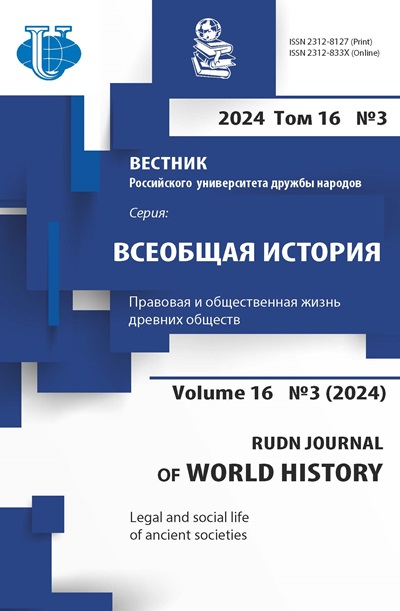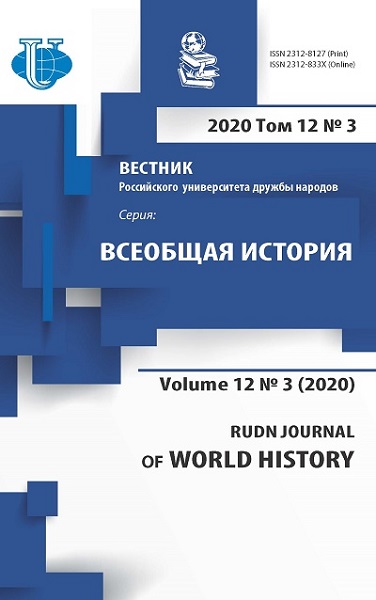Vol 12, No 3 (2020)
- Year: 2020
- Articles: 9
- URL: https://journals.rudn.ru/world-history/issue/view/1370
- DOI: https://doi.org/10.22363/2312-8127-2020-12-3
Full Issue
Ideas and politics in history
Concentration camps of Nazi Germany as a phenomenon. Opportunities and the problem of understanding
Abstract
This article deals with the Nazi concentration camps as a phenomenon of social life and social thought in Europe in the mid-second half of the twentieth century. Today, when the world is experiencing a crisis of political and social institutions, there is less and less hope that this realization will happen. It describes the prerequisites for the formation of the system of concentration camps in Nazi Germany, the forms of their functioning, and provides comparative data on the statistics of the number of camps. It is also pointed out the importance of understanding the processes of psychological destruction of a person in the camp.
 211-221
211-221


Role of education in the concept of the “New Society” of the authoritarian regime of Ferdinand Marcos in the Philippines (1972-1982)
Abstract
 222-235
222-235


Oriental Studies
The Features of Political and Religious Development of Oirats in the middle of the XIV - the middle of the XV centuries
Abstract
The period starting from the second half of the XIV century. and up to the middle of the 15th century, had held under the sign of the fall of the Mongol Yuan Dynasty in China, and it was the most important one in the history of the Eastern Mongols and Oirats. Until then, the rule that only representatives of the Golden Family (that is, the descendants of Genghis Khan) were able to receive power to govern over Mongols, was, in fact, not questioned, but later the various interpretations began to appear. For example, Oirats, as non-Genghisids, had to assert their power, possessing only second roles (Taishi - the first minister). Despite the internal turmoil and the struggle with the descendants of the Yuan rulers, the Oirats did to try to create the united Mongol state headed by Taishis from the Choros Oirat clan. After a long struggle with the Eastern Mongols (who sometimes had also been led by Oirats, for example Ugechi Khashig and his son Esehu) of such Oirat leaders as Batula, Batubolo, Taiping and Toghon, the son of the latter, Esen, managed to not only to unite the Oirats in a short time, but also to create the united Mongolian state. In addition, he revived the religious and political role of the sangha, most likely the teachings of black-caped hat Karma Kagyu. This act was especially important because, besides the ideological counterweight to the right of Genghisids, one should have responded to the growth of Islamic activity in the region.
 236-249
236-249


Abbasid and Samanid military institutions as historical background for the Ghaznawids
Abstract
Brilliant military achievements and fierce struggle between the sovereigns and his troops were characteristic of the Ghaznawid kingdom, the first Turkic dynasty in the history of Iran, while explanation of such paradox demands analysis of historical background for the Turkic rule. In view that one of the most important reasons for the decline of the Abbasids and the Samanids was the Turkic slaves’ arbitrary interference in the politics, the Abbasid and Samanid military institutions are researched in parallel. Scrutinize of narrative historical texts shows that the organization of armed forces under the two dynasties not only set an example for the Ghaznawids, but also prepared conditions for the Turkic ghulams’ rise to power, since originally the rulers of the two dynasties were forced to recruit them as reliance for the reign, while they were deprived of sovereignty with the strengthening of Turkic soldiers’ influence. Therefore, the Ghaznawids, maintaining the priority of the Turkiс component in the army, took precautions against the Turkic soldiers and generals.
 250-260
250-260


Modern World
An assessment of Ethio-China Political Economic Relations Since 1991
Abstract
 261-273
261-273


The Ethnic Minority Policy of Turkey
Abstract
 274-285
274-285


Retrospective of using the US universities and the Foreign Policy Association as elements of public diplomacy in the United States
Abstract
The article covers the period of implemetation of the leading US universities and the Foreign Policy Association as elements of US public diplomacy wchich their impact in economic, political and cultural influence all over the world. The author methodically and consistently cites analytical, historical facts proving an indirect and direct impact on the foreign policy of countries. The relevance of the article is due to the high significance and influence of non-state actors on world politics nowdays. The author points out that the political course of the leadership of the United States from the second half of the 20th century was focused on more active inclusion of the country in international politics and the rejection of isolationism, which was primarily reflected in the departure from the postulates of the Monroe Doctrine and the entry of the United States into the First World War. This, in turn, had a great influence on the development of public diplomacy in the United States as a tool to promote the interests of the country, the creation of the necessary information support for foreign policy actions of the state, as well as a favorable image of the United States in other countries. Thus it required the active involvement of the leading US universities in US public diplomacy, as well as the creation of new non-state institutions.
 286-291
286-291


Latin American Studies
Organizational structure of the Tupamaros National Liberation Movement in Uruguay (1965-1972)
Abstract
The article represents the first in Russian historiography attempt to consider in detail the structure of the revolutionary organization Tupamaros National Liberation Movement that acted in Uruguay in the 1960s and early 1970s. Due to the fact, that the Movement was clandestine, the data on the structure, strength, members could be reconstructed from both official documents and memoirs of members and leaders of the Movement. There are a lot of eminent persons of the contemporary history of Uruguay among them - ex President José Mujica, Vice President Lucía Topolansky, former Minister of Defense Eleuterio Fernández Huidobro and other important public figures. The study reveals the structural framework of the Tupamaros Movement and shows how were applied in practice two conflicting principles of the democratic centralism and internal autonomy of structural units of the organization.
 292-301
292-301


Reviews
A future without a script. Reflections on the publication of S. Ivanov
 302-305
302-305
















